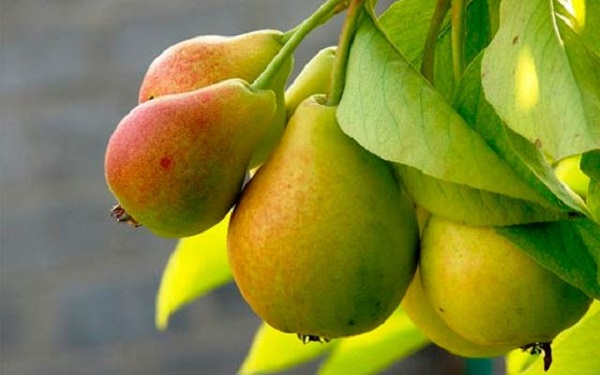Maria is simply considered a new pear variety, ripening in late autumn. Caring for her is easy. Because of this variety is popular among gardeners.
Maria is simply a medium-height tree with a compact, wide pyramidal crown. It can reach 3 meters. The diameter of the crown is 2.5 meters.
Table of contents
History of the appearance and description of the pear Just Maria
Simply, Maria is a sort of pear, which was bred in Belarus at the Institute of Horticulture by crossing the hybrid form 6 / 89-100 and the not very famous in Russia Oilya pear.
The famous breeders M. G. Myalik, O. A. Yakimovich and G. A. Alekseeva became the authors of the description of this variety and its preferential characteristics. The tree was originally called “Maria”, then it was renamed “Just Maria”. In 2005, this sort of pear was sent to the State Sorority Testing.
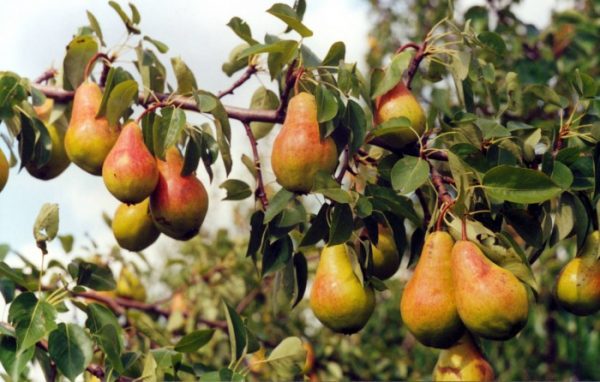
Pear Just Maria is recognized as a late variety, as it bears fruit in October. And for the summer pear variety Avgustovskaya Dew. The yield of this variety is not bad, and severe frosts in no way affect the quantity and quality of fruit. Maria is simply considered a winter-hardy variety that can withstand temperatures down to -38 ° C. After freezing, the trees quickly come to life and bring a lot of fruit.
Pear fruit is quite large. The average weight of ripened fruit is 180 g., The largest is no higher than 200 g, but in rare cases it reaches 230 g. Fruits are pear-shaped. Their surface is clean, smooth and shiny. Fruit stems are not very long and thick, slightly curved. The color of the fruit is greenish-yellow with a pink blush. Planting pollinators next to a pear, one can seriously increase its productivity.
The flesh is cream colored, their density is medium and oily.The fruit is sweet and juicy in taste, has a slight acidity.
The advantages and disadvantages of the variety
The benefits of the variety include:
- the taste of fruit that prevails over the rest of the varieties;
- the rapid onset of the fruiting period, that is, the crop is harvested for 3-4 years after planting;
- frost resistance - this variety is able to tolerate temperatures of -38 ° C;
- Simply, Mary is characterized by increased resistance to most diseases.
Of the deficiencies noted only average yields.
Planting pear
The best place for planting seedlings - the southern windless side of the garden.
A pear is planted in the fall when leaves fall before freezing. Saplings before planting are placed in the water for 5-7 hours. When the groove in the ground is ready for planting, take out the plant. A hole is dug out more, its depth is 1–1.5 m. A cone is made from soil and peat in it. The seedling is placed in a hole and the roots are distributed along the cone.
Fill the pit with fertile soil, a little tamping. A stake is driven in close to the plant, which will act as a support for the future tree.The sapling is tied to a cola with strips of cloth. After planting, the future tree is immediately watered, and loosen the ground around the root as soon as the soil absorbs water.

Growing conditions
Simply, Maria normally transfers shady terrain. However, the long presence of pears in such conditions leads to unhealthy development. Because of this, this variety is grown in areas where there is no shade.
For a tree, a sunny place is suitable, where the shadow partially falls on a tree.
Maria just needs moisture, especially in the summer. Therefore, it is necessary to create conditions for abundant and constant watering. Trees are watered not only in the first year after planting, but also all subsequent time.. Watering is carried out 4 - 5 times per season. For each tree, use about three buckets of water. After watering, it is necessary to loosen the soil so that the air penetrates to the roots.
Peculiarities of care
Variety Just Maria needs good care. Otherwise the tree will get sick, it will grow badly. In the autumn it can harm the rodents. In this regard, it is necessary to wrap the plants after planting with thick paper.
In winter, the pear root system may suffer. Therefore, in autumn, the tree is prepared for frost. For this, around the pear Just Maria is created an elevation from the ground. In addition, for insulation, you can cover the ground with leaves near the stem of the plant.
Young trees need:
- Have access to oxygen to the root system. Therefore, the pear must often loosen and weed.
- Frequent fertilizer.
- Permanent application of potassium, phosphorus and nitrogen. Nitrogen is mixed with the ground and poured into the groove before the flowering pear.
- For the normal ripening of the fruit at the end of the flowering of pears, you need to add a 0.4% solution of urea.
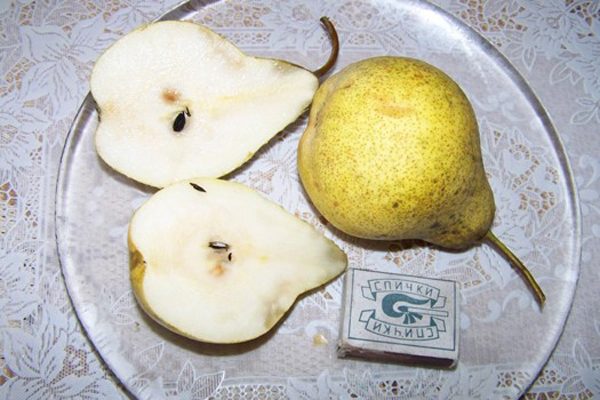
Harvesting
By the time of harvest Just Maria belongs to the autumn varieties. The consumer period of ripeness of this pear lasts from October to November. In the refrigerator, the fruit stays fresh until January.
The first harvest tree brings in the third year since its planting. It is possible to collect up to 40 kg of pears from one tree.
Special features
The fruits have a greenish-yellow color and a shiny skin. One pear fruit weighs approximately 200 grams. On fruit, there are subcutaneous points of greenish color. The fruits are small seeds that have a dark brown color.
Breeding
Pear Just Maria breeds cuttings, layering and grafting. Reproduction by cuttings is an effective way, which consists of the following actions:
- Take a green stalk from a mature pear and placed in conditions of 20–25 ° temperature. Thus, the cuttings will have roots in a short period of time.
- Selected pear stalk should be with leaves. This is necessary to watch how it will take root.
- A film coating is applied to maintain the desired temperature. But here such conditions are created for the cutting to prevent overheating of the air.
- To save the cutting from overheating, a damp cloth is pulled over it that does not obscure the pear. Otherwise, the plant will weaken and fail to develop properly.
- In the heat, cuttings are sprayed with water 5–6 times a day, but only when the sun is shining. On cloudy days, this procedure is carried out 2-3 times a day. Sprinkle pears until the leaves are completely wet.
- The cuttings in the greenhouse are placed so that they slightly exceed the ground level.
For this you can use tablets heteroauxin. These tablets dissolve in the water in which the cuttings are placed.
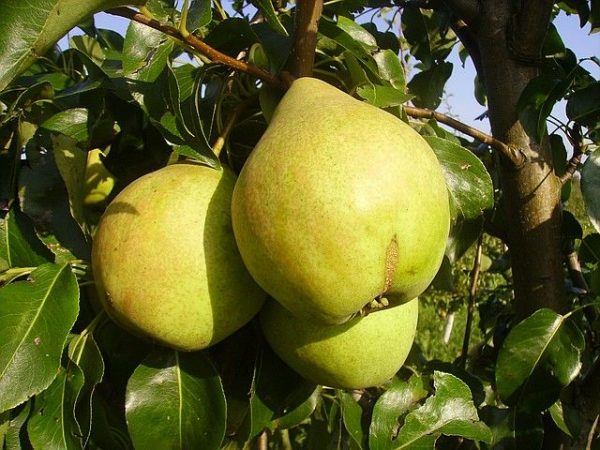
Reproduction by layering - This is the simplest method. As long as the pear survives, it will not be necessary to observe the natural conditions. For cuttings, you need to correctly pick shoots from a mature plant.
First, prepare the land in which the shoots can take root. For this, it is necessary that the landing site receives water and is saturated with oxygen. Also it should not get light.
When breeding pears apply ordinary shoots:
- The parent plant is almost not harmed when using this method;
- A branch of a plant is filled with soil, only its tip remains;
- Roots are formed in the place where the shoots are sprinkled with earth;
- When the roots appear in the right quantity in the right amount, it is disconnected from the parent plant.
- For successful root grafting, it is worth taking shoots with a developed ability to form roots. To do this, the branches are cut down one year before the roots are laid.
Reproduction by vaccination - complex and lengthy procedure. Its essence is to cut a branch from one plant and graft it onto another. The tree to be grafted is called a stock.
For vaccination you need:
- From the middle of the crown of a pear, simply Maria cut several one-year-old cuttings of such length so that three or four buds can fit. This action is carried out in early December, because the first frost hardens the wood.
- Gains are tied up in bunches and put into the basement. There they will winter.
- The graft is grafted onto a thin branch.
- The stock and the graft should be the same in diameter.
- The cut of a stock is done in a centimeter.
- For good survival, the graft and stock are cut at an acute angle.
- After bonding the scion and rootstock, they are wrapped in a stretch film and fixed with tape.
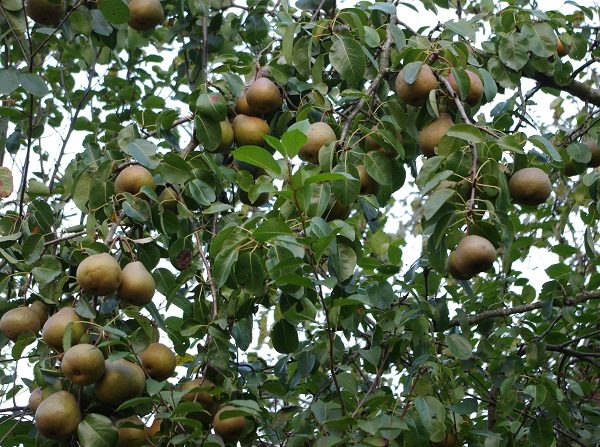
Diseases and pests
Maria is simply resistant to various damages, but the probability of infection is still present. In this regard, it is necessary to take measures for the prevention of septoriosis, scab and bacterial cancer.
Septoria - It is a disease of fungal nature. Spores of the fungus are in the fallen leaves. The appearance of this disease can be determined by the appearance of grayish-brown spots on the leaves. For the treatment of pear is carried out three procedures of processing the garden area. Initially, the plant is treated with a solution of nitrophen before disclosure of the kidneys. Then the pear is sprayed at the end of flowering with a solution of Bordeaux mixture. And the last time the tree is sprayed 15-20 days after flowering is also Bordeaux liquid.
Scab is a fungal disease. Spores are stored in the kidneys. Such a disease can be detected by detecting brown spots on the leaves of the pear and on its fruits.Methods of dealing with scab are the same as with septoria.
Bacterial cancer - The disease is also of fungal origin. Signs of this disease: cracked and blackened bark, brown spots are visible on the leaves, the fruits are black. To prevent a similar disease of the pear, damage to the bark should be excluded.
Gardeners reviews
Klimenko Irina: Maria is simply an incredibly tasty fruit. She can safely compete with the southern varieties of pears. At the tasting, simply Maria is 100% in the first place, since she has such qualities as yield, frost resistance, resistance to diseases and pests.
Anton Lebedev: Not really liked the taste of the fruit. I thought it was cloying. I can also note the flaws in the ovary when cold weather sets in when the pear blooms.
Volodonskaya Natalia: I just have a pear growing on my land. I am pleased that it ripens in the fall and is stored for a long time. Care for her is not difficult. The fruit itself is sweet and juicy.
Belarusian breeders truly cultivated a unique pear variety. Maria is simply adapted to cold winters, and this does not affect the quality and quantity of the crop, she is resistant to tree diseases.
It is also possible to regularly receive fruits with high taste characteristics from it. Plant a pear. Just Maria in your garden and enjoy the aromatic fruit!
